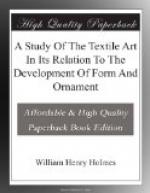Additional facility of expression is obtained by employing dark strands in the vertical series also, and large, isolated areas of solid color may be produced by changing the order of intersection, certain of the fillets being carried over two or more of the opposing series and in contiguous spaces at one step, as seen in Fig. 317. With these elementary resources the weaver has very considerable powers of expression, as will be seen in Fig. 318, which is taken from a basket made by South American Indians, and in Fig. 341, where human figures are delineated. The patterns in such cases are all rigidly geometric and exhibit stepped outlines of a pronounced kind. With impacting and increased refinement of fillets the stepped character is in a considerable measure lost sight of and realistic, graphic representation is to a greater extent within the workman’s reach. It is probable, however, that the idea of weaving complex ideographic characters would not occur to the primitive mind at a very early date, and a long period of progress would elapse before delineative subjects would be attempted.
I do not need to follow this style of combination into the more refined kinds of work and into loom products, but may add that through all, until perverted by ulterior influences, the characteristic geometricity and monotonous repetition are allpervading.
* * * * *
For the purpose of looking still more closely into the tendencies of normal textile decorative development I shall present a series of Indian baskets, choosing mainly from the closely woven or impacted varieties because they are so well represented in our collections and at the same time are so very generally embellished with designs in color; besides, they are probably among the most simple and primitive textile products known. I have already shown that several types of combination when closely impacted produce very similar surface characters and encourage the same general style of decoration. In nearly all, the color features are confined to one series of fillets—those of the woof—the other, the warp, being completely hidden from view. In the preceding series the warp and woof were almost equally concerned in the expression of design. Here but one is used, and in consequence there is much freedom of expression, as the artist carries the colored filaments back and forth or inserts new ones at will. Still it will be seen that in doing this he is by no means free; he must follow the straight and narrow pathway laid down by the warp and woof, and, do what he may, he arrives at purely geometric results.
[Illustration: Fig. 319. Base of coiled basket showing the method of building by dual coiling. The base or warp coil is composed of untwisted fiber and is formed by adding to the free end as the coiling goes on. The woof or binding filament, as it is coiled, is caught into the upper surface of the preceding turn—1/8.]




